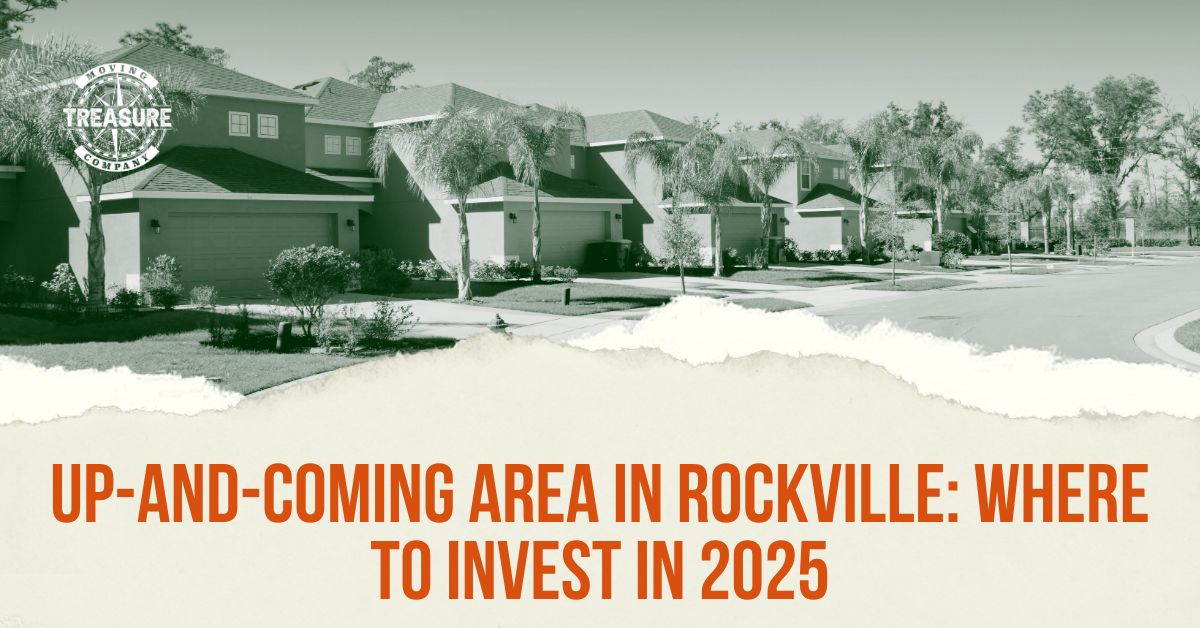
The most exciting up-and-coming area in Rockville centers around North Bethesda Metro Station, where a $33 million mixed-use development transforms nearly 14 acres into a life science and residential hub. Downtown Rockville's The Square also experiences dramatic revitalization with new restaurants and a Trader Joe's opening in summer 2025. These developments, combined with new residential communities like The Village at Rockshire and The Farmstead District, create opportunities for buyers seeking areas poised for significant growth.
Smart real estate decisions require understanding where cities invest their future. Rockville targets specific areas for transformation through infrastructure improvements and development incentives. These emerging neighborhoods offer better value than established areas while providing modern amenities. Early buyers benefit most from appreciation as areas mature.
Why Rockville's Emerging Areas Matter Now
Every up-and-coming area in Rockville shares common drivers that signal future success. Major infrastructure investments precede residential growth. Transit access attracts employers and residents simultaneously. Mixed-use development creates walkable communities people want. These factors combine to transform quiet sections into vibrant neighborhoods.
Timing matters significantly when buying in developing areas. Purchase too early and you wait years for promised improvements. Buy too late and prices already reflect future value. The sweet spot comes when projects break ground and early residents move in. This moment offers maximum upside with minimal waiting.
Economic trends support continued growth across Rockville's emerging areas. Tech sector expansion brings high-earning professionals to the region. Government employment in Washington remains stable and well-paying. Biotechnology companies establish operations near research facilities. This job diversity creates housing demand that developers rush to meet.
Development Patterns Signal Growth
Is Rockville, MD a good place to live? The answer increasingly points to yes, especially in areas receiving investment attention. City planners focus resources on transit-oriented development. Pedestrian infrastructure improves walkability in previously car-dependent zones. Public spaces get designed for community gathering and events.
Private investment follows public infrastructure spending predictably. Developers buy properties near new Metro stations before stations open. Restaurants and retailers lease space in mixed-use buildings early. These commitments signal confidence in area trajectories. Smart buyers recognize these patterns and act accordingly.
Property values in emerging areas appreciate faster than established neighborhoods initially. Limited existing housing stock means new construction sets price floors. Early buyers purchase below eventual stabilized values. This dynamic creates wealth-building opportunities that mature neighborhoods cannot match. This comprehensive Rockville City guide provides context about the broader market.
North Bethesda Metro Station: Rockville's Hottest Development Zone
The area surrounding North Bethesda Metro Station represents the premier up-and-coming area in Rockville for 2025. Major transformation reshapes nearly 14 acres adjacent to the station. The $33 million mixed-use project anchors broader neighborhood evolution. This development combines employment, housing, retail, and hospitality in one cohesive plan.
Institute for Health Computing Headquarters
The Institute for Health Computing selected this location for its new headquarters. This anchor tenant brings prestigious employment to the immediate area. Life science facilities attract biotechnology and healthcare companies. High-paying jobs create demand for nearby housing and services. The ripple effects extend throughout surrounding neighborhoods.
Life science complexes require specialized infrastructure and support services. Laboratory supply companies establish local distribution. Specialized contractors locate nearby for maintenance needs. Professional service firms open offices to serve industry clients. This ecosystem builds around major anchor tenants systematically.
Employment concentration drives residential demand in walkable distance. Professionals want minimal commutes to save time and money. Living near work eliminates parking costs and stress. This demand pushes property values higher as areas develop. Early residential buyers benefit from this predictable pattern.
Mixed-Use Development Components
Nearly 14 acres of development creates complete community rather than single-purpose zone. Residential housing serves workers and broader market simultaneously. Retail spaces provide shopping and dining without requiring cars. Hotel accommodations serve business travelers and visitors. This variety creates all-day activity that makes areas feel safe and vibrant.
Transit access amplifies mixed-use development benefits tremendously. Metro Red Line connects directly to downtown Washington in under 30 minutes. Commuters reach jobs without sitting in traffic daily. Parking costs disappear for transit users entirely. This convenience commands premium housing prices that grow over time.
Economic impact extends far beyond just construction activity. Montgomery County expects substantial tax revenue increases from completed development. New residents support existing businesses throughout Rockville. The project establishes this area as premier walkable hub. Property values within half-mile radius continue rising as construction progresses.
Walkability transforms previously car-dependent areas into pedestrian-friendly neighborhoods. Sidewalks connect residential buildings to Metro stations safely. Protected bike lanes accommodate cyclists commuting or running errands. Street-level retail creates interesting walking environments. These features attract buyers prioritizing sustainability and convenience.
Downtown Rockville's The Square Renaissance
Downtown Rockville's central hub, rebranded as The Square, experiences dramatic revitalization. New restaurants and retailers breathe life into this historic area. Community events and performances activate public spaces regularly. This transformation establishes downtown as another key up-and-coming area in Rockville.
New Dining Scene Emerges
Recent restaurant openings demonstrate downtown's growing appeal and momentum. Kusshi Sushi brought quality Japanese dining to the area in 2024. Little Miner Taco added casual Mexican options for quick lunches and dinners. Fork & Kitchen plans opening soon with New American cuisine featuring Southern influences. These additions complement existing establishments drawing steady crowds.
Restaurant variety attracts residents from throughout Rockville and beyond. Dining options span from affordable ethnic cuisine to upscale experiences. Food quality rivals restaurants in more expensive downtown Washington. This culinary scene creates reasons to visit beyond just necessity. Property values near restaurant clusters show consistent appreciation.
Evening activity increases as dining options multiply in concentration. Restaurants create foot traffic that supports other businesses nearby. Well-lit streets with pedestrians feel safer than empty commercial zones. This virtuous cycle accelerates as more establishments open. Early property buyers benefit from this predictable transformation.
Trader Joe's Transforms Grocery Shopping
Trader Joe's opened in summer 2025, fundamentally changing downtown dynamics. This popular chain attracts shoppers from throughout Rockville daily. The location makes downtown a destination rather than occasional visit. Foot traffic from grocery shopping supports all surrounding businesses. Property values near this anchor retailer show immediate impact.
Grocery access makes downtown living practical for more households. Residents can walk for weekly shopping instead of driving elsewhere. This convenience particularly appeals to empty nesters and young professionals. Housing demand increases when daily needs get met locally. Developers notice this pattern and plan more residential projects.
The store's presence signals confidence in area trajectory from national retailer. Trader Joe's researches locations extensively before committing to leases. Site selection considers demographics, traffic patterns, and growth potential. Their decision validates downtown's transformation and future prospects. This endorsement influences other retailers' location decisions positively.
Community Events Build Connections
The Square hosts events creating community bonds throughout the year. Summer concert series brings live music to outdoor spaces weekly. Farmers markets operate during growing season with local vendors. Holiday celebrations draw families for traditional festivities and activities. These gatherings create shared experiences strengthening neighborhood identity.
Public space activation makes areas feel welcoming and safe consistently. Events demonstrate city investment in downtown's success and vitality. Regular programming creates habits that bring people downtown repeatedly. This consistent activity supports property values and business success. Communities with strong public life attract buyers seeking engagement.
New Residential Communities Creating Opportunities
Fresh housing developments represent the most accessible up-and-coming area in Rockville options. These communities combine new construction benefits with strategic locations. Builders focus on walkability and amenities that modern buyers demand. Early buyers position themselves for appreciation as areas mature.
The Village at Rockshire Opens Fall 2025
This new EYA neighborhood brings anticipated housing options to market. Single-family homes and townhomes provide choices for different household sizes. Nearby parks offer recreation without leaving the immediate community. Retail access sits within walking distance for daily convenience needs. The development timing positions early buyers for maximum appreciation potential.
EYA's reputation for quality construction reduces buyer concerns about defects. The builder focuses on community atmosphere beyond just housing units. Architectural variety prevents cookie-cutter appearance common in developments. Thoughtful landscaping and common areas create appealing environments. These details justify premium pricing that holds value long-term.
Location selection demonstrates developer confidence in area trajectory and growth. Builders research market trends extensively before committing capital. Site purchases happen years before construction begins typically. The Village at Rockshire location signals belief in surrounding area development. Buyers benefit from this professional market analysis and expertise.
The Farmstead District Completes King Farm
This final phase of King Farm development delivers brand-new homes. Modern layouts incorporate open concepts and current design trends. The walkable environment reduces car dependency for daily activities significantly. Transit-friendly location serves commuters heading downtown via multiple routes. Established King Farm amenities become immediately available to new residents.
King Farm's proven success reduces risk for Farmstead District buyers. The broader community demonstrates sustained demand and value appreciation. Schools, parks, and shopping already exist rather than requiring future development. Community culture welcomes newcomers into established social networks. This combination rarely exists in entirely new developments.
Final phase positioning creates urgency among interested buyers naturally. Limited inventory in popular communities drives competition and prices. Buyers recognize this represents last chance for new construction here. Developers leverage this psychology in pricing and marketing strategies. Early phase buyers historically see strongest appreciation in successful communities.
Fallsgrove Continues Attracting Interest
While not brand new, this mixed-use community maintains momentum. The village center includes dining and grocery shopping within walking distance. Over 80 acres of green space provide recreation and natural beauty. Strong community feel develops through regular events and neighbor interactions. The combination of convenience and character makes this perpetually desirable.
Fallsgrove demonstrates how thoughtful planning creates lasting value and appeal. Mixed-use design anticipated current preferences for walkable communities. Green space preservation satisfies desire for nature amid development. Community programming builds social connections residents value highly. These features explain sustained demand decades after initial development. For comprehensive neighborhood coverage, check this detailed neighborhoods guide.
Budget-Friendly Emerging Opportunities
Affordable areas to live in Rockville MD exist even within developing zones. Strategic choices provide entry into growth areas without maximum pricing. Some locations offer excellent value before broader market recognizes potential. Early buyers benefit most from appreciation as recognition increases.
Identifying Value in Growing Areas
Cheap areas to live in Rockville MD often sit adjacent to major developments. Properties one or two blocks from main projects cost significantly less. But proximity allows benefiting from improvements and amenities being built. This location strategy maximizes value while minimizing initial investment.
Older housing stock in emerging areas presents renovation opportunities. Dated finishes reduce purchase prices substantially below new construction. Strategic updates increase value and personal enjoyment simultaneously. Sweat equity converts into home equity as neighborhoods improve. This approach suits buyers with renovation skills or budgets.
Apartment rentals in developing areas cost less than established neighborhoods. Landlords price competitively to attract tenants during construction phases. Once areas mature, rents increase to match improved amenities. Early renters lock in lower rates through lease terms. This creates savings while evaluating whether to buy eventually.
Twinbrook Offers Metro Access Affordably
Twinbrook provides the most accessible entry into Metro-connected living. Home prices average around $500,000, well below Rockville medians. Rental options also cost less than most city areas. The Twinbrook Metro station provides direct access downtown without car ownership. Rock Creek Park sections offer free recreation and nature.
Area improvements gradually transform Twinbrook into more desirable destination. New businesses open as resident demographics shift upward over time. Property maintenance improves as owners invest in renovations and updates. These changes happen slowly but create appreciation for patient buyers. Early investment positions for maximum long-term gains.
Transit-oriented development principles guide Twinbrook's evolution gradually forward. Denser housing near stations reduces car dependency systematically over time. Retail follows residential density in predictable patterns developers understand. Infrastructure improvements make walking and biking safer and more pleasant. These changes compound to transform neighborhoods fundamentally over decades.
Shady Grove Area Apartments
Multiple apartment communities near Shady Grove Metro offer rental affordability. Competition between complexes keeps prices moderate despite quality amenities. Metro station proximity reduces transportation expenses substantially for residents. Modern features rival more expensive properties in established neighborhoods. These communities provide budget entry into developing corridor:
- Axis at Shady Grove: Contemporary apartments at moderate monthly rates
- The Flats at Shady Grove: Floor plans from studios to two-bedrooms
- The Daley at Shady Grove: Modern design with competitive pricing
- Camden Shady Grove: National management with professional operations
Rental living allows participating in area growth without purchase commitment. Lease terms provide flexibility if circumstances change unexpectedly during development. Lower monthly costs compared to mortgages leave budget room elsewhere. This approach suits people evaluating Rockville before buying permanently. For family-specific guidance, explore this family neighborhoods guide.
Investment Indicators for Smart Buyers
Understanding what makes an up-and-coming area in Rockville succeed helps identify opportunities. Multiple factors signal which developing zones will appreciate strongest. Smart buyers recognize these patterns before prices fully reflect potential.
Infrastructure Investment Signals
Public infrastructure spending precedes private development consistently in patterns. Roads get widened and improved before major projects break ground. Utility capacity increases to handle denser development loads planned. Parks and public spaces get created to serve incoming residents. These investments signal government confidence in area trajectories.
Transit improvements create immediate property value impacts within walkable distances. New Metro stations or bus rapid transit lines transform accessibility. Properties within half-mile radius see strongest appreciation from transit access. This effect compounds as ridership grows and service improves. Early buyers capture maximum value from these infrastructure investments.
Pedestrian infrastructure demonstrates commitment to walkable community development goals. Protected bike lanes encourage non-car transportation for daily trips. Wider sidewalks accommodate increased foot traffic comfortably and safely. Street trees and lighting make walking pleasant and secure feeling. These details separate successful mixed-use developments from failed attempts.
Private Development Momentum
Major anchor tenants choosing locations validate area potential professionally. Companies research extensively before committing to long-term leases. Site selection considers workforce accessibility, business climate, and growth trajectory. Their decisions represent professional analysis individual buyers cannot replicate. Following their location choices provides market intelligence.
Multiple developers targeting the same area signal consensus on potential. Competition for development sites drives land prices upward before construction. This indicates strong market expectations for completed project success. Buyers benefit from this professional confidence and capital commitment.
Retailer commitments provide tangible evidence of consumer demand expectations. National chains research demographics and traffic patterns exhaustively before opening. Local businesses opening second locations show confidence in customer base. Restaurant variety indicates disposable income levels that support housing values. These commercial indicators predict residential market strength.
Making Your Emerging Area Decision
Choosing the right up-and-coming area in Rockville requires balancing multiple factors carefully. Timeline expectations influence which development stage suits you best. Risk tolerance affects whether you buy during construction or after completion. Budget constraints determine which emerging areas remain accessible financially.
Visit developing areas at different times before committing to purchases. Morning visits during construction reveal noise and disruption realities. Afternoon exploration shows current resident activity levels and demographics. Evening assessment indicates how safe areas feel during darker hours. These observations ground decisions in reality rather than marketing promises.
Research development timelines and potential delays that could affect plans. Construction schedules slip regularly due to weather, permitting, and financing. Infrastructure projects often take longer than initially announced publicly. Factor these realistic timelines into your decision-making process. Patience becomes essential virtue when buying in developing areas.
Talk with current residents about their experiences during neighborhood transformation. Ask specific questions about construction disruption and timeline accuracy. Inquire about promised amenities that did or didn't materialize. Request honest assessment of whether they'd make same decision again. Real conversations reveal details developers won't mention voluntarily.
Is Rockville, MD a good place to live? For people seeking growth opportunities and modern communities, absolutely yes. The city targets specific areas for strategic development and transformation. Public and private investment creates momentum that individual buyers cannot generate. Whether you choose North Bethesda Metro area, downtown The Square, or new residential communities, Rockville delivers emerging opportunities. These developing zones offer better value than established neighborhoods while providing modern amenities and future appreciation potential that make them smart choices for 2025.

